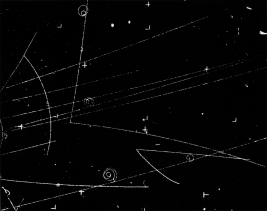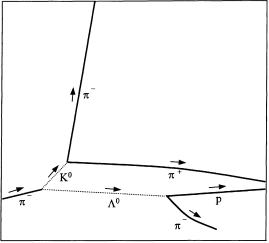


 الفيزياء الكلاسيكية
الفيزياء الكلاسيكية
 الكهربائية والمغناطيسية
الكهربائية والمغناطيسية
 علم البصريات
علم البصريات
 الفيزياء الحديثة
الفيزياء الحديثة
 النظرية النسبية
النظرية النسبية
 الفيزياء النووية
الفيزياء النووية
 فيزياء الحالة الصلبة
فيزياء الحالة الصلبة
 الليزر
الليزر
 علم الفلك
علم الفلك
 المجموعة الشمسية
المجموعة الشمسية
 الطاقة البديلة
الطاقة البديلة
 الفيزياء والعلوم الأخرى
الفيزياء والعلوم الأخرى
 مواضيع عامة في الفيزياء
مواضيع عامة في الفيزياء|
Read More
Date: 9-11-2015
Date: 11-12-2015
Date: 26-5-2016
|
Murray Gell-Mann

Chicago and Strangeness
Gell-Mann's stay at the Princeton institute was productive but temporary. Oppenheimer was impressed with his work but could not offer a faculty position. A friend from MIT, Marvin Goldberger, who was now an assistant professor at the University of Chicago and would eventually become president of the California Institute of Technology (Caltech), promoted his cause at Enrico Fermi's Institute of Nuclear Studies. The only position available was a lowly instructorship, but Fermi's institute was the place to be in the early 1950s. For a former New Yorker, Chicago had its limitations, and the weather could be abominable, but the disadvantages were countered by Fermi's presence. At the time, Fermi was the greatest practicing physicist, a notch above Oppenheimer, Rabi, Weisskopf, and even Bethe.
Fermi was a pragmatist who avoided excessive mathematics. Pauli called him a “quantum engineer,” but the direct approach had brought Fermi triumphs in both experimental and theoretical physics. Fermi's style, with its similarities to Weisskopf's, appealed to Gell-Mann. It was just what was needed to reap a rich harvest from the data then emerging from the Chicago cyclotron and other particle accelerators in Berkeley and at the Brookhaven National Laboratory on Long Island.
The unidentified particles that announced themselves most distinctively in the particle detectors left a V-shaped track. At first, they were called “V-particles,” and as the mystery of their origin deepened, they were dubbed “strange.” In the mid-1950s, Gell-Mann opened the door to the world of strange particles with two tools that had been valuable to quantum physicists for many years: the concepts of the quantum number and the conservation law. Reduced to its essentials, Gell-Mann's scheme assigns a quantum number called “strangeness” to each strange particle, and adopts the principle that this quantum number does not change it is conserved in strong interactions, although it may change if weak interactions come into play. (Remember that strong interactions take place among neutrons and protons in atomic nuclei, and also within neutrons and protons among their constituent particles, for which Gell-Mann later supplied the name “quarks.”)
Particle physicists use the label “hadron” for all particles such as protons and neutrons that are subject to strong interactions. They further classify hadrons as “baryons,” with comparatively large masses, and “mesons,” with intermediate masses. Another category of particles, called “leptons,” includes the lightest ones: electrons and neutrinos.
Gell-Mann's rules of strangeness are illustrated by the particle reaction induced when a high energy beam of mesons called “pions” enters a chamber filled with liquid hydrogen. The pions react with the protons present as hydrogen nuclei, and two strange particles are produced:
p + π _ → Λ0 + K0, (1)
in which p is a proton, π _ is a pion carrying a negative electrical charge (it has two siblings, π 0 and π +, which are, respectively, neutral and positively charged), and Λ0 and K0 are both neutral strange particles, the former a baryon and the latter a meson. When the pressure is suddenly dropped in a liquid-hydrogen chamber, charged particles in transit through the chamber reveal their presence by leaving behind a trail of bubbles. It is said that this detection device, called a “bubble chamber,” was suggested to its inventor, Donald Glaser, as he meditated on the rising bubbles in a bottle of beer. The bubble chamber was a successor to the Wilson cloud chamber.
The tracks in a bubble chamber shown in figure 1.1 tell the story of the particle reaction described above and represent Gell-Mann's strangeness scheme in action. An interpretation of the photograph, which omits all extraneous tracks, is supplied in figure. 1.2. Notice first the curvature of many of the tracks, caused by a strong magnetic field applied perpendicularly to the bubble chamber. (Maxwell's equations tell us that any electrical current follows a curved path in a magnetic field.) That curvature can be accurately measured and it reveals both the charge and the mass of the particle responsible for the track.

Figure 1.1. Photograph of tracks induced in a hydrogen-filled bubble chamber by a beam of high-energy, negatively charged pions. This photograph is reproduced by permission from the Lawrence Berkeley National Laboratory.

Figure 1.2. Interpretation of fig. 1.1. Only the relevant tracks are shown.
A highly energetic pion enters the bubble chamber on the left side of the picture in figure 1.2, encounters a proton (a hydrogen nucleus), and reaction (1) takes place, producing the Λ0 and K0 particles. They are both electrically neutral, and therefore leave no tracks in the bubble chamber. But they subsequently decay (break apart) into charged pions and protons according to
K0 → π - + π + (2)
and
Λ0 → p + π - (3)
Gell-Mann's rules assign values of the strangeness quantum number S as follows: S = 0 for non-strange particles (p, π +, and π - in the example), S = +1 for K0, and S = -1 for Λ0. Thus the total strangeness quantum number for the left side of reaction (1) is 0 + 0 = 0, and for the right side the total is the same: - 1 + 1 = 0. The strangeness is therefore conserved in the reaction, as required for a strong interaction by Gell-Mann's scheme.
On the other hand, reactions (2) and (3) do entail a change in the strangeness quantum number, from +1 to 0 in reaction (2), and from -1 to 0 in reaction (3). Such changes in strangeness rule out strong interactions (and electromagnetic interactions), and indicate weak interactions. The length of a track in a bubble chamber, actually seen or inferred, is a measure of the “lifetime” of the particle before it “dies” in a subsequent reaction. The paths followed by the K0 and Λ0 particles in figure 1.2 indicate comparatively long lifetimes of particles that decay through weak interactions. The times are not really long typically 10-8 second but they are longer by many orders of magnitude than they would be if the particles decayed through strong interactions. There would be no direct evidence for K0 and Λ0 in the bubble chamber if their decay could follow the strong route.



|
|
|
|
دراسة تحدد أفضل 4 وجبات صحية.. وأخطرها
|
|
|
|
|
|
|
العتبة العباسية تستعدّ لتكريم عددٍ من الطالبات المرتديات للعباءة الزينبية في جامعات كركوك
|
|
|